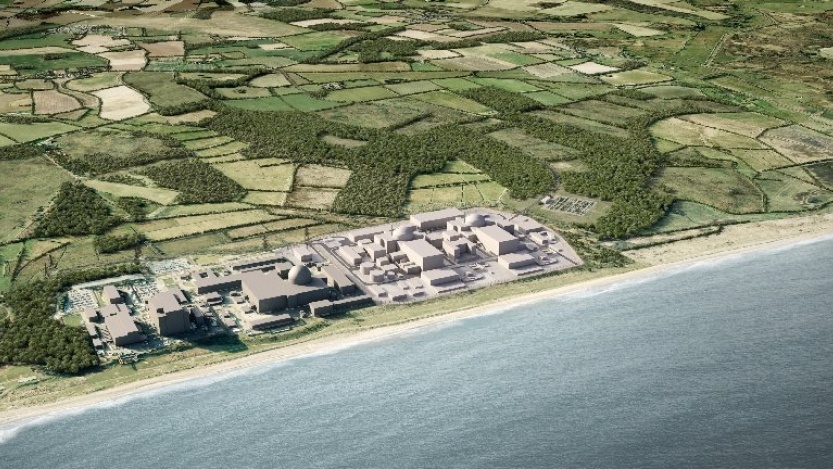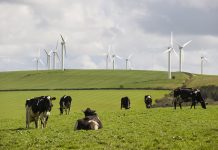Prospects for Sizewell C, Britain’s second new nuclear mega-project, advanced today as energy secretary Kwasi Kwarteng confirmed £100 million of government cash to encourage investors.
While not a direct investment, the taxpayer-funded lure aims to spur development of the EDF-led venture, by enticing cash from other non-state backers.
D-BEIS began talks last year with EDF about the 3.2GW ‘nationally significant infrastructure project’ near Saxmundham, on the Suffolk coast near Aldeburgh. Last May EDF submitted a planning application for its EPR design.
Standing next to Sizewell B, commissioned in 1995, the new station will employ 900 full time workers. It is anticipated to run for sixty years.
Though China’s CGN formally has a 20% stake in the Suffolk plant and is co-funding Hinckley C now under construction, the UK government has been working under pressure from Washington on a financial structure to oust the Beijing-accountable entity.
One likely solution is D-BEIS taking a stake in a development company that will push Sizewell C through various stages of planning and bureaucracy, sharing the costs with EDF.
“Considering high global gas prices, we need to ensure Britain’s future energy supply is bolstered by reliable, affordable, low-carbon power that is generated,” Kwarteng said.
“New nuclear is not only an important part of our plans to ensure greater energy independence, but to create high-quality jobs and drive economic growth.”
Kwarteng added the funding will also further support the development of Sizewell C during this important phase of negotiations as the government seeks to maximise investor confidence in this “nationally significant” project.
Sizewell C’s output is predicted to meet the needs of six million homes, and save around nine million tonnes of carbon each year compared with gas-fired generation. During construction, up to 10,000 skilled jobs would be created across the UK.
Private sector investors such as insurers L&G and Aviva would then pledge their stakes at a later stage in return for a government-backed funding model called the regulated asset base (RAB), diluting the taxpayer and EDF. Legislation on RAB funding – the same model used to fund airports such as Heathrow and water companies – was passed by parliament last year.
EDF has lobbied intensively for a RAB mechanism, arguing it could slash Sizewell’s guaranteed strike price to under £60 per MWh. Hinkley Point C’s equivalent of £92.50 MWh has been criticised as excessive at a time when offshore wind costs are falling.
“Throwing taxpayers’ money at it’: Greenpeace
All but one of Britain’s eight existing nuclear power stations are due to shut by 2030.
Simone Rossi, chief executive of EDF Energy, said today: “We’re very pleased that the government is showing its confidence in Sizewell C which, if approved, will lower energy costs for consumers and help to insulate the UK from global gas prices.
“Together with our own investment, these funds will allow us to continue to move the project towards a financial investment decision.”
Rossi said Sizewell C will benefit from being a near replica of Hinkley Point C in Somerset and will provide a “huge economic boost” to east Suffolk where it already enjoys the support of most local people.
Unite general secretary Sharon Graham urged the government to “take the handbrake off” and speed up the process.
“The government needs to sit down with EDF now, not later in the year, and agree a funding model that allows Sizewell to start with no further delay,” she said.
Dr Doug Parr, Greenpeace UK’s policy director, was less admiring. Using taxpayers’ money as a lure was an admission that nuclear was not commercially viable, he alleged.
“They are so fixated on getting 20th-century nuclear technology delivered, they’ll just keep throwing taxpayers’ money at it”, Parr commented.
He added: “Including all the other subsidy sources, Sizewell C will now have subsidised development, subsidised construction, subsidised power production and subsidised waste management, for a project by a subsidised company.”
At the Spending Review in 2021, the government made up to £1.7bn of new direct funding available for developing a large-scale nuclear project. D-BEIS and Treasury are not yet formally committed. A final investment decision could be made in this Parliament.
Built to the same EPR design, the troubled Olkiluoto plant was connected to Finland’s grid only last month, twelve years behind schedule. Today it is reported that commissioning tests have resulted in an unplanned trip out. A further fortnight’s delay will ensue in three months of trials.





The UK should consider alternative nuclear power technologies, as the EPR cools with water at around 350 bar and 390C which requires the very expensive safety containment building to contain any meltdown. Cooling by molten salt or metal reduces the need for a high working pressure and reduce the risks. Moltex Energy, a British company is building their first commerical power station in Canada with a Canadian Government subsidy, using molten salt as the heat transfer fluid; this technology could be used here in the UK. Disclosure: I have no financial interest in Moltex Energy.